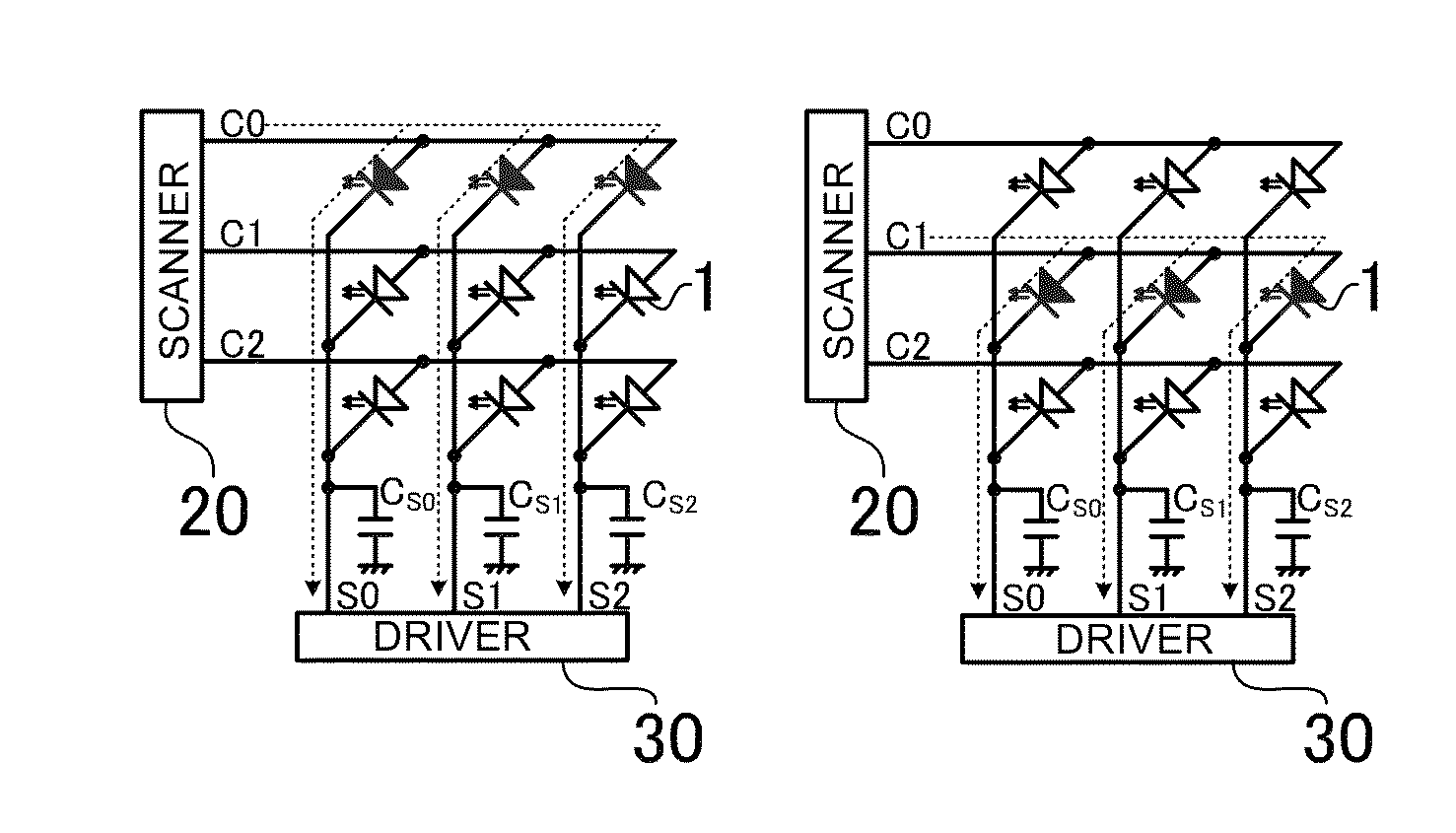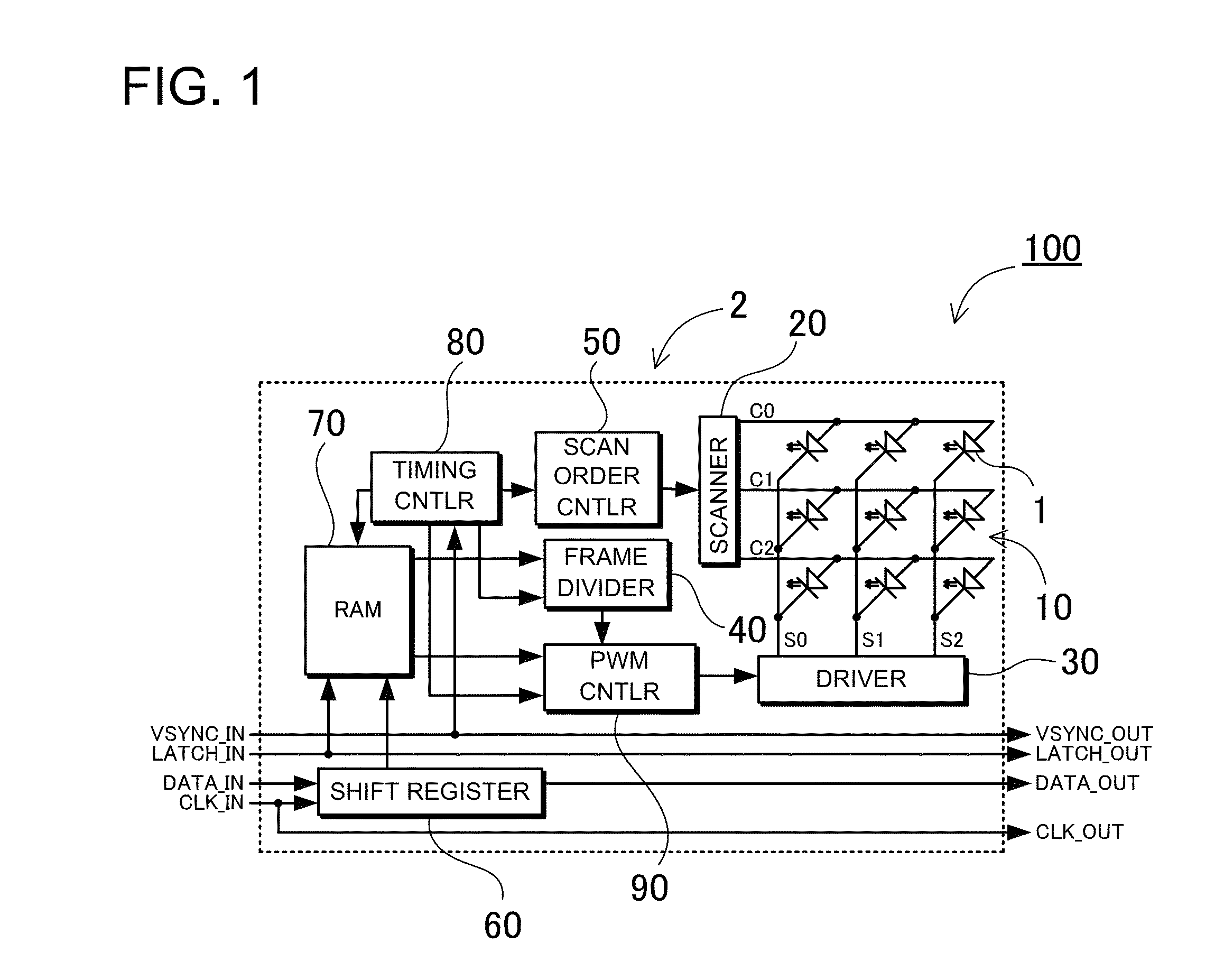Display apparatus light emission control method and display unit
a technology of light emission control and display apparatus, applied in the field of display apparatus, can solve the problems of inversely affecting display quality and the brightness of light emitting elements that are first driven in each cycle, and achieve the effect of reducing the amount of light intensity
- Summary
- Abstract
- Description
- Claims
- Application Information
AI Technical Summary
Benefits of technology
Problems solved by technology
Method used
Image
Examples
first embodiment
[0047]FIG. 1 is a block diagram showing a display unit 100 according to a first embodiment of the present invention. FIG. 2 is a timing chart showing a light emission control method for driving the display unit 100. FIGS. 3A to 3J are circuit diagrams showing current flows indicated by the arrows in the display unit in sub-frames shown in FIG. 2.
(Display Portion)
[0048]The display unit 100 includes a display portion 10 and a light emission control portion 2, as shown in FIG. 1. The display portion 10 includes a plurality of light emitting elements 1, a plurality of common lines C0 to C2, and a plurality of driving lines S0 to S2. The light emitting elements 1 are arranged in a matrix. Each of the common lines C0 to C2 is connected to the anode terminals of the light emitting elements 1 that are arranged in corresponding one of rows. Each of the common lines S0 to S2 are connected to the cathode terminals of the light emitting elements 1 that are arranged in corresponding one of colum...
second embodiment
[0059]The method according to the foregoing embodiment has been described to change the row that is first driven depending on cycles so that the dark line cyclically appears in different rows depending on cycles. In this method, the rows of the display portion 10 are driven in a first light emission order in a first cycle, while the rows of the display portion 10 are driven next to the first cycle in a second light emission order so that the row that is first driven in the second light emission order is different from the row that is first driven in the first light emission order. However, the present invention is not limited to this method. One(s) of the rows can be driven in one frame in one cycle, and other one(s) or the other rows can be driven in the one frame or a frame following the one frame in the one cycle. According to this method, the row that is first driven in each cycle can be also changed depending on cycles. As a result, it is also possible to suppress the dark line...
third embodiment
[0073]The foregoing second embodiment mentioned has been described to control the driving portion so that the activation timing period (a series of activation timing sub-frames) for activating the driving lines extends over frames, and the sub-frames for activating the driving lines continuously extend correspondingly to one frame. However, it is not necessary to control the driving line so that the sub-frames for activating the driving lines continuously extend correspondingly to one frame. The sub-frames for activating the driving lines can be distributed. FIG. 5 shows this type of control method according to a third embodiment. In this illustrated light emission control method, between the sub-frames where one row and the next rows are driven, the common lines are scanned, while the driving lines are deactivated (a non-light emission period are provided). That is, dissimilar to the foregoing first and second embodiments, a series of contiguous activation timing sub-frames for act...
PUM
 Login to View More
Login to View More Abstract
Description
Claims
Application Information
 Login to View More
Login to View More - R&D
- Intellectual Property
- Life Sciences
- Materials
- Tech Scout
- Unparalleled Data Quality
- Higher Quality Content
- 60% Fewer Hallucinations
Browse by: Latest US Patents, China's latest patents, Technical Efficacy Thesaurus, Application Domain, Technology Topic, Popular Technical Reports.
© 2025 PatSnap. All rights reserved.Legal|Privacy policy|Modern Slavery Act Transparency Statement|Sitemap|About US| Contact US: help@patsnap.com



